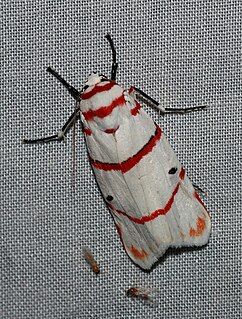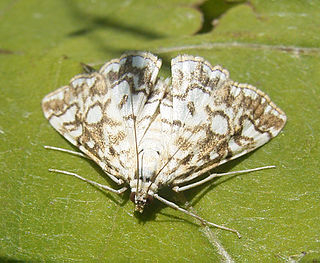Related Research Articles

Spilomelinae is a very species-rich subfamily of the lepidopteran family Crambidae, the crambid snout moths. With 4,132 described species in 340 genera worldwide, it is the most speciose group among pyraloids.

The Thyrididae comprise the family of picture-winged leaf moths. They are the only family in the superfamily Thyridoidea, which sometimes has been included in the Pyraloidea, but this isn't supported by cladistic analysis.

Hypena is a genus of moths in the family Erebidae. It was first described by Franz von Paula Schrank in 1802. These non-migratory moths overwinter as pupae and almost never come to bait as adults.

Agylla is a genus of moths in the subfamily Arctiinae. The genus was erected by Francis Walker in 1854.

Asura is a genus of moths in the subfamily Arctiinae erected by Francis Walker in 1854.

Cisthene is a genus of lichen moths in the family Erebidae. The genus was erected by Francis Walker in 1854.

Conilepia is a monotypic moth genus in the subfamily Arctiinae erected by George Hampson in 1900. Its only species, Conilepia nigricosta, was first described by John Henry Leech in 1888. It is found in Japan and Taiwan.

Cyana is a genus of moths in the family Erebidae. Species are well distributed in Africa, Madagascar, China, India, Sri Lanka, Myanmar, Sumatra, Java and Borneo. The genus was erected by Francis Walker in 1854.
Heliosia is a genus of moths in the family Erebidae erected by George Hampson in 1900.
Lambula is a genus of moths in the family Erebidae. The genus was erected by Francis Walker in 1866.

Macaduma is a genus of moths in the subfamily Arctiinae.

Miltochrista is a genus of moths of the family Erebidae, subfamily Arctiinae. The genus was erected by Jacob Hübner in 1819.

Eoophyla is a genus of moths of the family Crambidae. It was erected by Charles Swinhoe in 1900.
Erupa is a genus of moths of the family Crambidae.

Evergestis is a genus of moths of the family Crambidae described by Jacob Hübner in 1825. A number of species are pests, including the cross-striped cabbageworm, a pest of cole crops such as cabbage.
Goniorhynchus is a genus of moths of the family Crambidae.

Pycnarmon is a genus of moths of the family Crambidae described by Julius Lederer in 1863.

Acontia is a genus of moths of the family Noctuidae. The genus was named by Ferdinand Ochsenheimer in 1816. Eusceptis, Pseudalypia and Spragueia are sometimes included in the present genus, but here they are tentatively treated as different pending further research. Many species of Tarache were also once placed here.

Aphomia is a genus of small moths belonging to the family Pyralidae. Some breed in the nests of Anthophila, where their caterpillars are parasitic feeders of wax, honey and pollen.

Acentropinae is a fairly small subfamily of the lepidopteran family Crambidae, the crambid snout moths. Species of this subfamily are exclusively found in wetlands and aquatic habitats.
References
- ↑ Savela, Markku (May 17, 2015). "Disaulota Hampson, 1900". Lepidoptera and Some Other Life Forms. Retrieved October 17, 2019.
- Pitkin, Brian & Jenkins, Paul. "Search results Family: Arctiidae". Butterflies and Moths of the World. Natural History Museum, London.
| This Lithosiini-related article is a stub. You can help Wikipedia by expanding it. |